Most people researching hair transplant in Turkey don’t actually know the real difference between FUE and DHI. They’re two of the most talked-about techniques in our country’s rising hair restoration scene, yet often described as if one simply replaced the other. That’s not quite true.
At their core, both FUE (Follicular Unit Extraction) and DHI (Direct Hair Implantation) rely on the same foundation: extracting healthy hair follicles from the donor area and implanting them into thinning regions. What changes is how those follicles are implanted, the precision, the control, and the surgeon’s level of involvement.
Over the past decade, we’ve visited dozens of clinics across Istanbul, Kadıköy, Beşiktaş, and Ataşehir. We’ve spoken with surgeons that are all pioneers in refining these methods. And what we’ve learned is that the “best” choice isn’t about buzzwords or equipment. It’s about matching the right method to the right patient.
In this guide, we’ll explore the real differences between DHI and FUE, what each method offers, who they suit best, and how Turkey became the global capital for both. You’ll also find honest insights on pricing, results, recovery, and the surgeons behind the most respected clinics in Istanbul.
Quick Facts: DHI vs FUE Hair Transplant
- Both methods deliver 95–98% graft survival when performed in doctor-led clinics.
- FUE covers larger bald areas, while DHI refines front hairlines and temples with pinpoint precision.
- Recovery time: 3–5 days for basic healing, 10–14 days for full recovery.
- Final results appear around 12–15 months post-operation.
- FUE hair transplant in Turkey costs around $2,000–$3,500 on average.
- DHI hair transplant in Turkey costs between $2,800–$4,500, depending on graft count and surgeon participation.
Quick Answer
If you’re comparing DHI vs FUE, think of it this way: FUE is ideal for covering large bald areas efficiently, while DHI gives finer control for designing natural, high-density hairlines.
In Turkey, FUE costs around $2,000–$3,500, and DHI ranges between $2,800–$4,500, depending on graft count and surgeon involvement.
Both methods deliver permanent results when performed by Ministry of Health–licensed and ISHRS-certified clinics. Many Istanbul surgeons combine both — FUE for coverage, DHI for detail.
The Difference Between DHI and FUE
Here’s what surprises most people: both DHI (Direct Hair Implantation) and FUE (Follicular Unit Extraction) start the same way, by extracting grafts one by one from the donor area. The main difference lies in how they’re implanted.
- In FUE, the surgeon first opens microchannels in the recipient area, then places grafts into those channels using forceps or sapphire blades.
- In DHI, grafts are implanted directly using a CHOI implanter pen, skipping the channel-opening step.
This tiny procedural change affects everything from surgery time to recovery speed and even pricing. According to the International Society of Hair Restoration Surgery (ISHRS), both techniques fall under the same surgical category but differ in precision and pace.
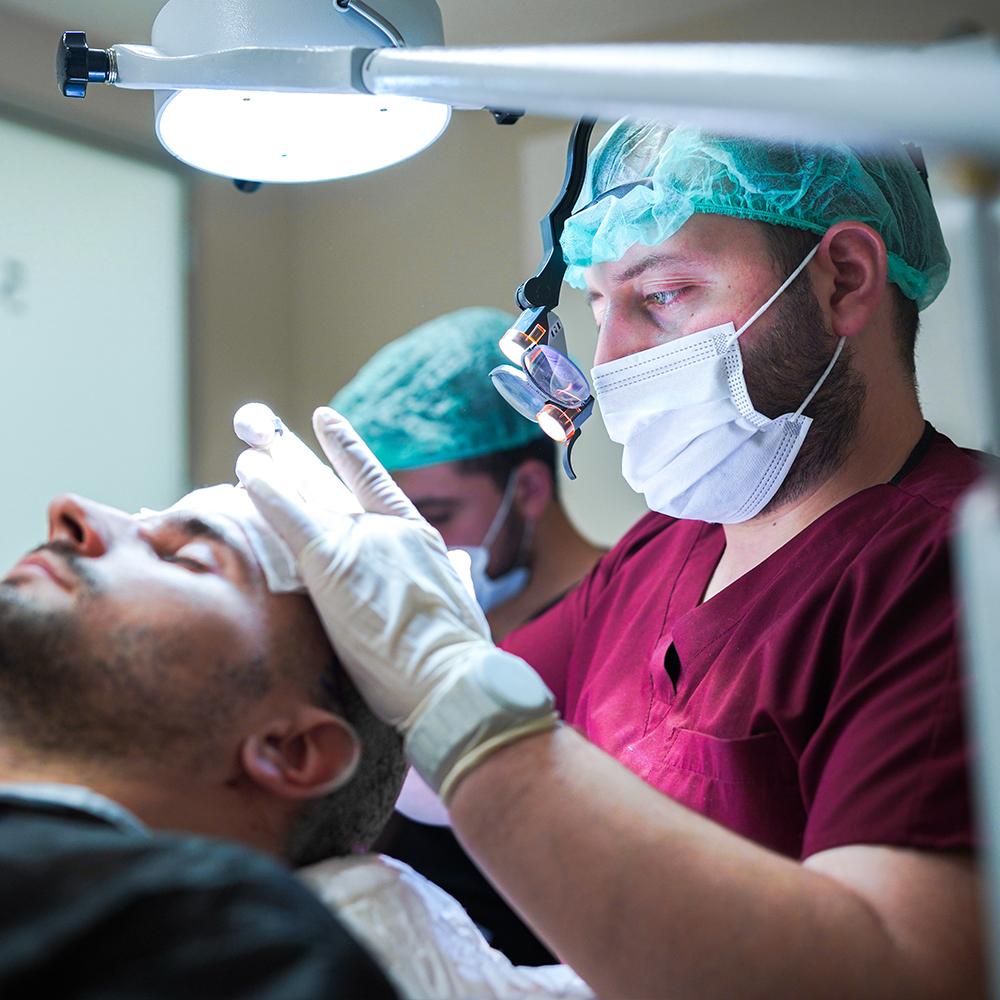
Studies published in J Cutan Aesthet Surg. by Sethi & Bansal (2013) also support that direct implantation methods reduce graft exposure time and may enhance follicle survival in skilled hands.
Dr. Gökhan Bilgin – Smile Hair Clinic:
“FUE gives us volume, DHI gives us control. We decide which one leads depending on your hairline design.”
If you’re targeting maximum coverage, FUE is often the smarter route. If your goal is dense, natural hairlines with minimal trauma, DHI may be worth the higher price tag.
How Each Technique Works: Step-by-Step Process
Most people assume FUE and DHI are completely different. In truth, they’re siblings, that is same roots, slightly different personalities. Both extract individual hair follicles from the donor zone (usually the back of your head). The distinction comes afterward: what happens between extraction and implantation.
Let’s break them down clearly.
FUE Hair Transplant: Precision and Speed Combined
The FUE (Follicular Unit Extraction) technique involves taking follicular units one by one using a micro punch (usually 0.7–1.0 mm). The extracted grafts are then stored in a chilled, nutrient-rich solution until they’re ready to be implanted.

Typical Steps:
- Planning & Design: The surgeon draws your hairline and marks donor areas.
- Extraction: Follicles are gently removed with a micromotor or manual punch.
- Storage: Grafts are preserved in saline or PRP to keep them vital.
- Implantation: Microchannels are opened using steel or sapphire blades, then grafts are placed carefully with forceps.
Many good clinicsuse Sapphire FUE, a refinement that uses sapphire blades instead of steel, helping create cleaner incisions and smoother healing.

According to the American Academy of Dermatology (AAD), FUE provides excellent density when executed under optimal temperature and hydration. The ISHRS 2024 census reported FUE as the most performed hair restoration method worldwide.
Dr. Ahmet Murat – Hermest Hair Clinic:
“We treat every follicle like an organ transplant. The faster and safer it’s handled, the higher the survival rate.”
DHI Hair Transplant: Control and Density in Every Move
DHI (Direct Hair Implantation) uses a CHOI implanter pen, a small tool that allows the surgeon to extract and implant grafts almost simultaneously. Instead of creating channels first, the pen directly inserts follicles into the scalp at precise angles and depths.
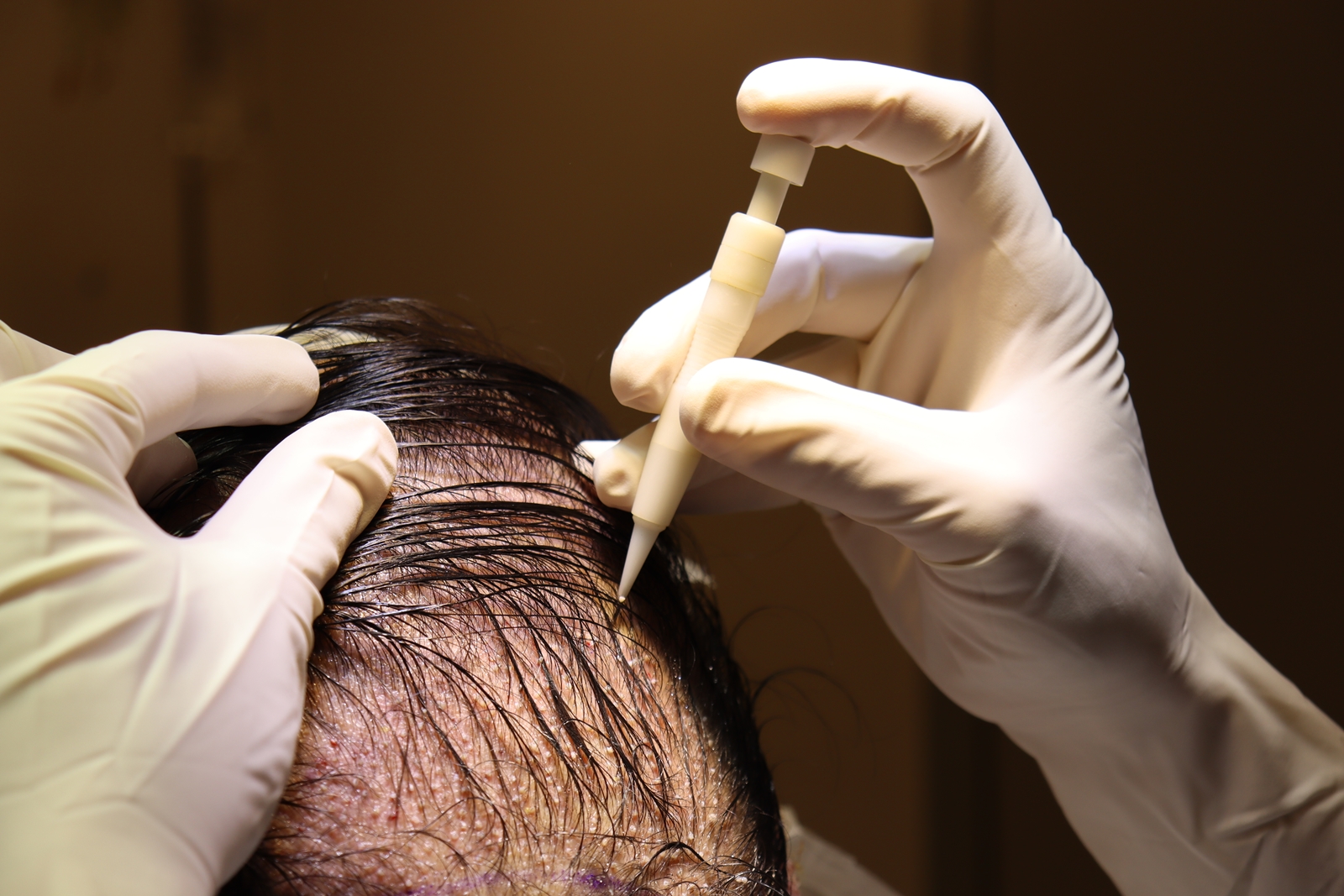
Typical Steps:
- Design & Mapping: Detailed density plan and angle mapping, especially around the hairline.
- Extraction: Individual follicles are removed just like in FUE.
- Implantation: Each graft is loaded into the CHOI pen and placed instantly, with no pre-made incisions.
According to a study by Sethi & Bansal (2013) published in the Journal of Cutaneous and Aesthetic Surgery, this direct method shortens the graft’s “out-of-body” time, improving survival potential when performed by experienced teams.
Dr. Gökhan Bilgin – Smile Hair Clinic:
“DHI gives us surgical rhythm, every pen stroke is a controlled decision. It’s perfect for hairlines, crowns, and areas demanding fine artistry.”
The Istanbeautiful team observed during clinic visits that DHI procedures tend to run longer but feel calmer. There’s less bleeding, almost no visible channels, and noticeably less post-op swelling.
The Bottom Line
Both methods rely on steady hands and sharp planning. FUE wins in efficiency and area coverage, while DHI shines in density and design precision.
According to PubMed and StatPearls (2024), the best outcomes come when surgeons choose the method based on the patient’s donor quality, scalp elasticity, and desired coverage, not marketing promises.
Istanbeautiful Insight:
“When surgeons adapt the technique to your scalp, not the other way around, that’s when art meets science.”
Cost Comparison: DHI vs FUE in Turkey (2025)
Ask any patient researching DHI vs FUE in Turkey, and cost quickly becomes part of the equation. But pricing isn’t just about numbers. It reflects the time, technique, and surgeon involvement behind the procedure.
According to USHAŞ 2025 Health Tourism Data, Turkey continues to offer the most competitive rates worldwide while maintaining certified safety standards. The secret? Experienced doctors, high procedure volumes, and efficient clinic systems, not shortcuts.
Average Hair Transplant Prices in Turkey
| Method | Average Cost (2025) | Per Graft Range | Best For |
|---|---|---|---|
| FUE (Follicular Unit Extraction) | $2,000–$3,500 | $0.40–$1.00 | Large coverage areas |
| DHI (Direct Hair Implantation) | $2,800–$4,500 | $0.80–$1.25 | High-density or refined hairlines |
| Sapphire FUE | $2,400–$3,800 | $0.60–$1.10 | Natural density and faster recovery |
These numbers are based on findings from the Turkish Health Tourism Association (THTC) and verified price ranges from best hair transplant clinics in Istanbul.
Why DHI Is More Expensive
DHI usually costs 20–30% more than FUE because:
- It requires CHOI pens, which must be sterilized or replaced per patient.
- Implantation is slower, limiting daily cases (often one patient per day per surgeon).
- It demands higher surgeon involvement during every graft placement.
On the other hand, FUE allows larger sessions (up to 4,000–5,000 grafts) in a single sitting, making it more cost-effective for extensive baldness.
According to a 2024 report by Forbes Health, Turkey’s combination of medical quality and affordability saves international patients an average of 70% compared to UK or US clinics, even after including flights and hotel stays.
Example: Cost of 3,000 Grafts in Turkey
- FUE: Around $2,300–$2,800
- Sapphire FUE: $2,600–$3,100
- DHI: $3,200–$3,800
Many all-inclusive packages in Istanbul include 4-star hotel accommodation, VIP transfers, post-op medications, and follow-up consultations.
Istanbeautiful Team Note:
“From what we’ve seen, pricing transparency is strongest among Ministry-licensed clinics. Always request a written graft estimate and inclusions list before booking.”
What You Actually Pay For
When comparing hair transplant cost in Turkey, remember you’re not just paying for grafts that you’re paying for:
- The surgeon’s time and experience
- Clinic accreditation and hygiene standards
- Post-op care and follow-up communication
- PRP therapy or exosome add-ons (if included)
According to the International Society of Hair Restoration Surgery (ISHRS), global pricing variation often comes down to surgeon-led vs technician-led models, that is a distinction that Turkish clinics are now more transparent about.
Recovery, Results & Healing Differences Between DHI and FUE
The recovery process is often what patients worry about most, especially those planning their trip to Turkey around work schedules or limited vacation days. The truth? Whether you choose DHI or FUE, recovery is usually faster and more comfortable than people expect.
According to the American Academy of Dermatology (AAD) and recent PubMed reviews, both techniques show minimal pain and short healing time when performed correctly. The difference lies mainly in the number of steps and how the scalp heals afterward.
Recovery Timeline: FUE vs DHI
| Stage | FUE Recovery | DHI Recovery |
|---|---|---|
| Days 1–3 | Mild swelling and redness in both donor and recipient zones. | Slight swelling, less redness thanks to pen implantation. |
| Days 4–7 | Scabs form in the implanted area; first clinic wash performed. | Minimal scabbing, faster initial healing. |
| Days 8–10 | Most scabs fall off; redness fades. | Scalp usually clear by day 7. |
| 2–3 Weeks | Shock shedding begins; grafts enter resting phase. | Same timeline, sometimes slightly milder shedding. |
| 1–3 Months | Minimal visible growth, follicles activate under the skin. | Similar, but density may appear earlier in smaller zones. |
| 6–12 Months | Hair thickens, texture softens, full results appear. | Slightly earlier visible density (around month 9–10). |
Dr. Gökhan Bilgin – Smile Hair Clinic:
“DHI recovery feels easier mostly because there are no channel incisions. But long-term results depend more on graft survival and care, not the method name.”
Comfort & Scarring
Both methods are minimally invasive and don’t leave linear scars.
- FUE leaves micro-dot marks in the donor area that fade naturally.
- DHI often avoids visible scarring entirely, especially in smaller sessions.
Many top clinics use PRP-assisted washing and cooling masks, reducing redness by up to 40% faster.
Patient Feedback from Istanbul
Most international patients return to normal daily activities or remote work within 3–5 days. Light gym and travel typically resume after 10–14 days.
Istanbeautiful Team Observation:
“We’ve seen patients walk through Istanbul’s bazaars two days post-surgery, wearing hats, sipping Turkish coffee, feeling fine. The comfort difference between FUE and DHI is smaller than most expect.”
According to Healthline, key recovery factors are hydration, avoiding tight hats, and consistent washing. The method matters, but the aftercare routine determines how cleanly you heal.
Result Durability
Both DHI and FUE produce permanent results, since the transplanted follicles come from genetically resistant donor zones. The ISHRS 2024 Census confirms that graft survival averages 95–98% in licensed Turkish clinics using sterile conditions and proper storage temperatures.
Choosing the Right Method: FUE, DHI or a Hybrid Approach
Once you understand both techniques, the question shifts from “which is better?” to “which suits me?” That’s where context matters, that is your age, donor density, lifestyle, and expectations all play a part.
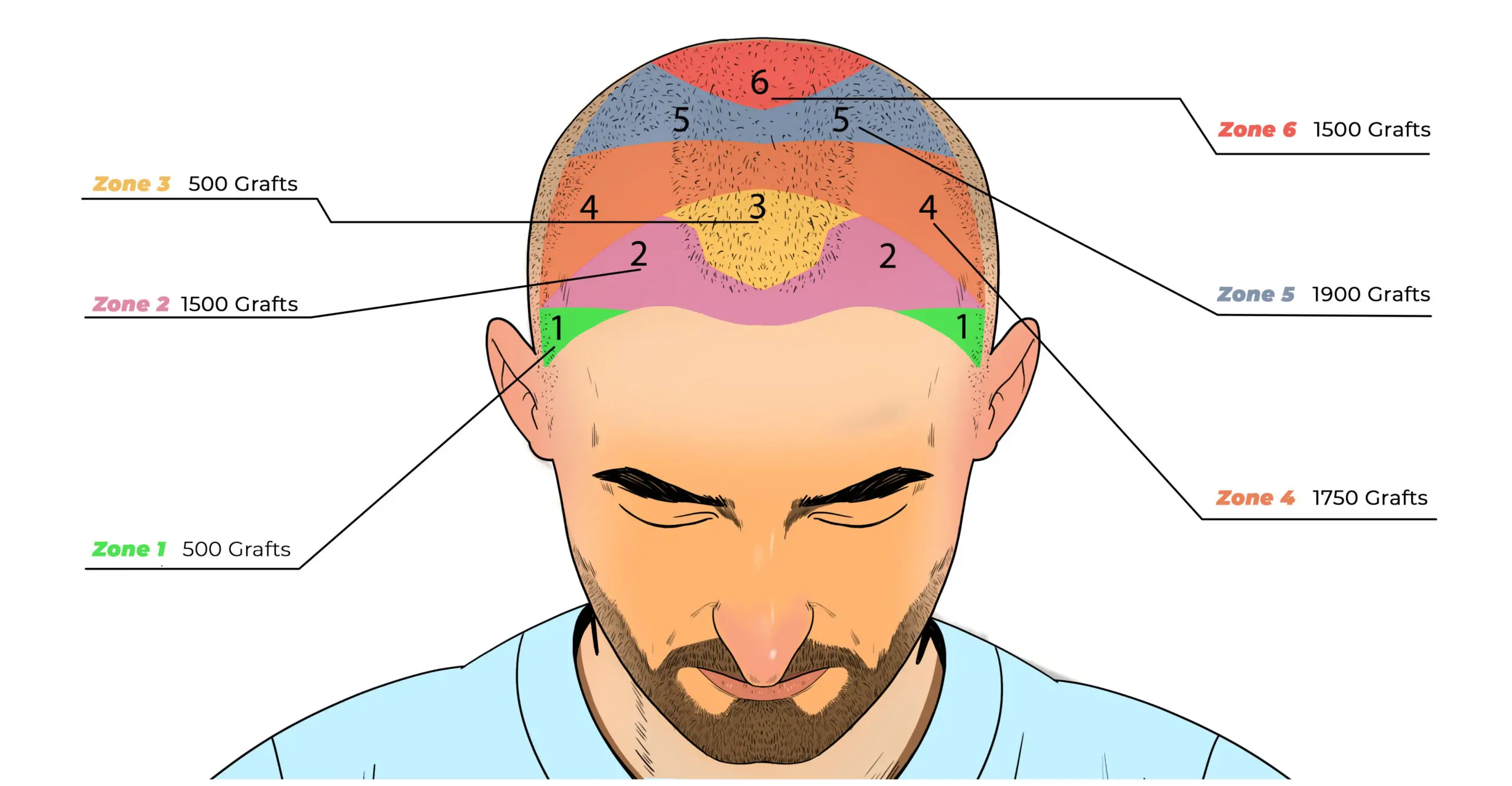
According to the International Society of Hair Restoration Surgery (ISHRS) and StatPearls 2024, no single technique outperforms the other in every case. The winning formula depends on matching the right tool to the right scalp.
When FUE Makes More Sense
- You need large-area coverage (3000 – 5000 grafts or more).
- Your priority is maximum value per graft.
- You prefer a shorter operation with fewer sessions.
- Your donor area is strong and consistent.
Many good hair transplant clinics perform advanced Sapphire FUE, allowing higher density and smoother healing for broad restoration zones.
Dr. Ahmet Murat – Hermest Hair Clinic:
“FUE gives us scale. It’s like painting a wide canvas quickly but carefully. perfect for major coverage.”
When DHI Is the Better Fit
- You want dense, natural hairlines or fine work around the temples.
- You’re targeting smaller areas or filling existing hair.
- You need a shorter recovery window with minimal scabbing.
- You value precision over volume.
As described in the Journal of Cutaneous and Aesthetic Surgery (Sethi & Bansal, 2013), the CHOI-pen system shortens graft exposure time and enhances survival, but only when handled by trained teams.
Dr. Gökhan Bilgin – Smile Hair Clinic:
“DHI is for detail. Every implant stroke shapes direction and flow.”
Why Hybrid Techniques Are Growing
Many Istanbul surgeons now combine both FUE for coverage, and DHI for design.
This blended approach reduces overall operation time while giving surgeons artistic control in the visible zones.
Dr. Güncel Öztürk – HairNeva Clinic:
“We use FUE to build the structure and DHI to draw the story line. That balance is what makes results look truly natural.”
According to Healthline and PubMed 2024 clinical data, mixed-method procedures show slightly higher satisfaction scores among international patients because they adapt to each case instead of forcing a single method.
Istanbeautiful Advice
- Ask your surgeon why they recommend one method over the other.
- Request a clear graft map showing where each technique will be applied.
- Confirm that your chosen clinic is Ministry of Health–licensed and lists its daily patient limit.
Safety, Risks & Red Flags to Watch Before Choosing a Clinic
The truth is, neither DHI nor FUE is risky when performed by a qualified team in a licensed Turkish clinic. But as medical tourism grows, so do corner-cutting operations that see patients as numbers, not individuals. Knowing what to look for keeps you safe, and saves you from regret later.
Main Safety Standards to Look For
According to the Republic of Türkiye Ministry of Health, all surgical hair restoration centers must be licensed, employ at least one full-time medical doctor, and operate under hospital-grade sterilization standards. You can (and should) ask to see their registration certificate.
The International Society of Hair Restoration Surgery (ISHRS) and European Hair Restoration Society (EHRS) both emphasize surgeon-led procedures.
Common Red Flags
- No visible doctor involvement during planning or incision stages.
- Suspiciously cheap prices (under $1,500 total for full transplants).
- Aggressive online marketing promising unlimited grafts.
- Unclear communication about aftercare or anesthesia.
- Crowded schedules, where clinics treat 10+ patients a day.
A study published in Symposium: Hair in Derm (2018) by Kerure & Patwardhan found that most post-surgery complications came from unregulated centers or technicians performing graft placement without medical supervision.
Realistic Risk Profile
When done properly, both FUE and DHI have very low complication rates, that is less than 1% according to StatPearls 2024. Minor issues like swelling, temporary redness, or mild folliculitis can appear but resolve quickly. Permanent side effects are rare and usually linked to poor donor handling.
Many hair clinics all keep emergency-trained anesthesiologists on-site and perform full pre-op blood tests before surgery, following AAD and ISHRS best practices.
Istanbeautiful Advice
Before booking, confirm three things:
- The clinic license (Sağlık Bakanlığı logo visible on paperwork).
- The doctor’s ISHRS or EHRS membership.
- A written guarantee of surgeon involvement, graft count, and aftercare plan.
Istanbeautiful Team Note:
“If a clinic hesitates to share names or medical credentials, walk away. Good clinics are proud to show their paperwork, and their surgeons.”
FUE vs DHI Results & Patient Experience: What Real People Report
If you’ve ever scrolled through hair transplant forums or watched YouTube diaries, you’ll notice something interesting: patients rarely talk about “techniques” after surgery. They talk about how natural their hairline looks, how quickly they healed, and whether the process felt personal. That’s where the real difference between FUE and DHI becomes clear.
Results in Numbers
According to the International Society of Hair Restoration Surgery (ISHRS) 2024 Census, both FUE and DHI achieve graft survival rates of 90–98%, depending on surgeon skill and post-op care.
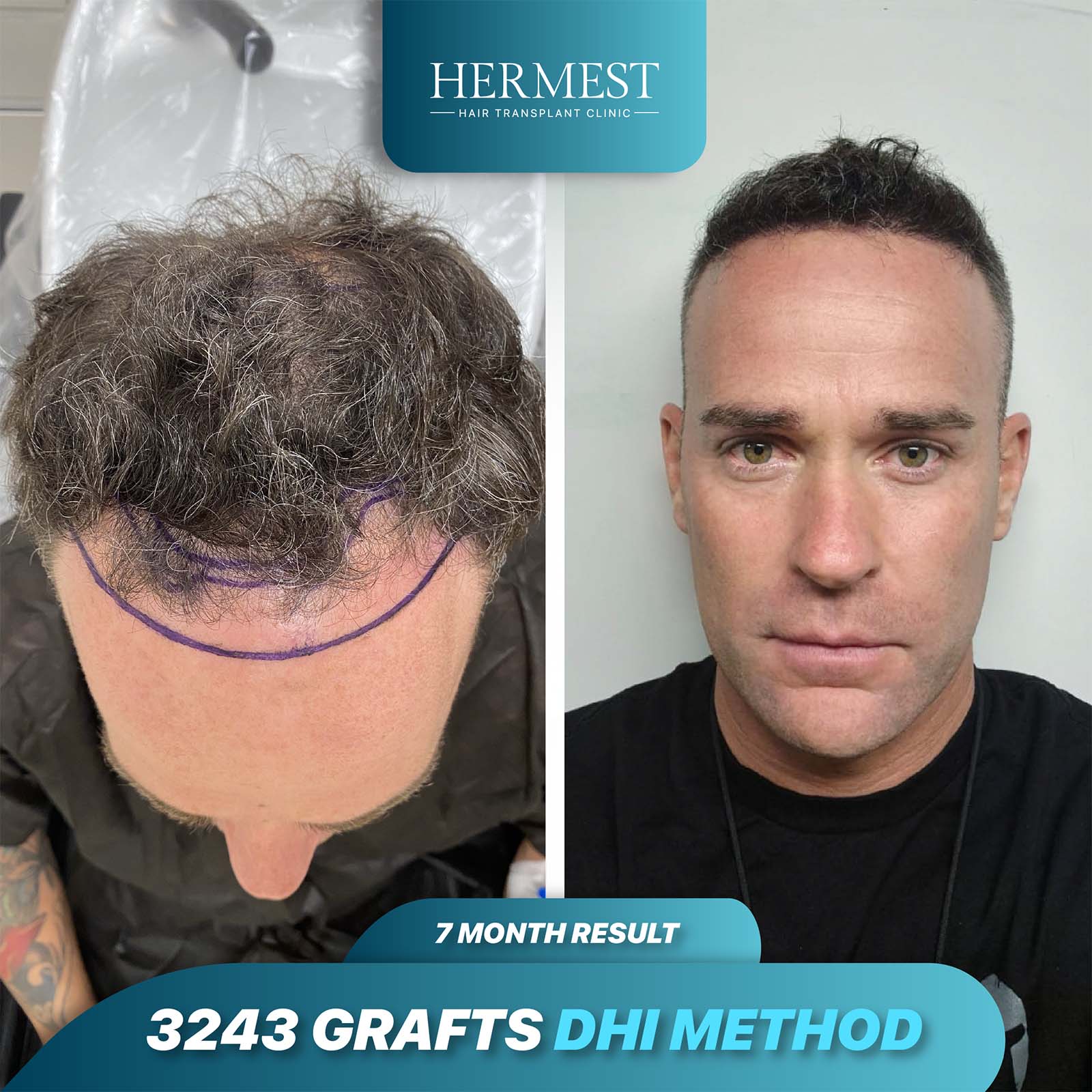
A PubMed review comparing graft outcomes across 1,500 Turkish and European patients showed no significant long-term difference in density, but DHI scored higher on immediate aesthetic balance in hairline and crown areas.
The American Academy of Dermatology (AAD) adds that while FUE remains the global standard, direct implantation (DHI) can improve growth direction accuracy by 10–15% in skilled hands.
Patient Feedback: Istanbul Clinics
During our visits to leading clinics in Istanbul, patients shared similar themes:
- FUE patients appreciated speed and affordability, especially those doing large sessions (3,500+ grafts).
- DHI patients talked about comfort, cleaner recovery, and confidence in visible zones like the hairline.
- Those who had hybrid sessions (FUE + DHI) said they felt they got “the best of both worlds”, coverage plus artistry.
Before & After Insights
According to Healthline and Forbes Health reports, the biggest visible transformation happens between months 4 and 9, when transplanted follicles start producing thicker strands. Full maturity, that is density, direction, and shine, usually peaks around month 12–15.
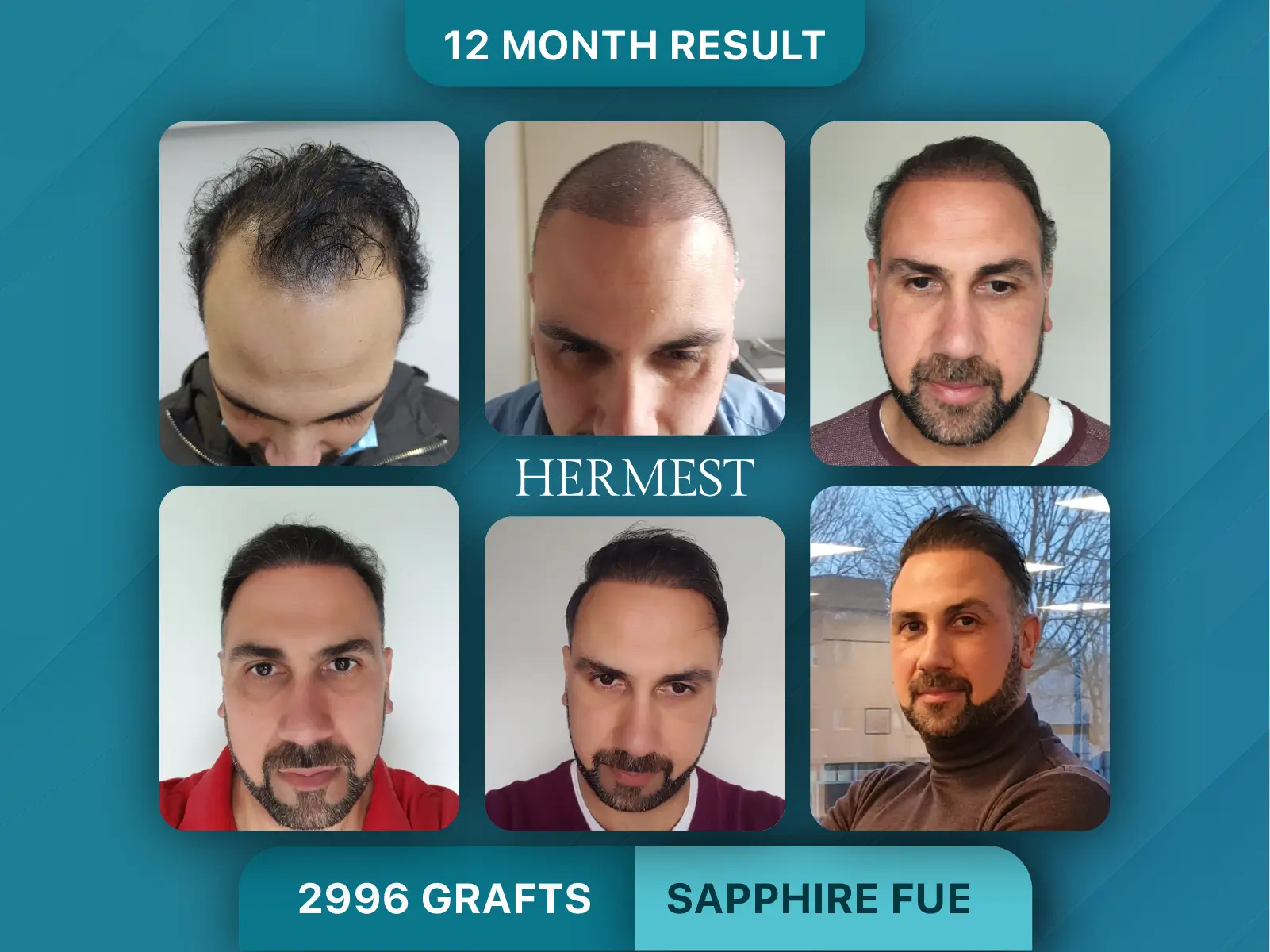
Many Turkish clinics like Hermest document every patient’s progress with standardized photography and graft-tracking systems. This transparency builds trust and gives international patients peace of mind even after flying home.
How Satisfaction Is Measured
Patient surveys published by Haider (PubMed, 2024) show that 88% of international visitors who chose Turkey for FUE or DHI rated their experience as “excellent” or “better than expected.”
What patients valued most wasn’t just outcome. It was honest consultation, surgeon visibility, and post-op communication.
That matches what we’ve seen firsthand: Turkish clinics succeed not only because of price, but because of predictability. Patients know what to expect, what’s included, and who’s responsible for their results.
Istanbeautiful Insight:
“The most satisfied patients weren’t the ones chasing density. they were the ones who trusted the process and stayed patient.”
FUE vs DHI Comparison Table (2025 Quick Guide)
| Category | FUE (Follicular Unit Extraction) | DHI (Direct Hair Implantation) |
|---|---|---|
| Technique Overview | Hair follicles are extracted one by one, then implanted into pre-made microchannels. | Hair follicles are extracted and implanted directly using a CHOI implanter pen; no channels needed. |
| Surgery Duration | 5–7 hours on average, depending on graft count. | 6–9 hours; slower due to one-by-one implantation. |
| Best For | Large bald areas, crown coverage, overall density restoration. | Small or detailed zones like the hairline and temples. |
| Session Size | Up to 4,000–5,000 grafts per session. | Usually 2,500–3,500 grafts per session due to precision limits. |
| Healing Time | 7–10 days; scabs fall off naturally. | 5–7 days; typically fewer scabs and less swelling. |
| Pain & Comfort | Mild discomfort under local anesthesia. | Slightly less trauma, smoother healing experience. |
| Scarring | Tiny micro-dots in donor area, fade over time. | Almost invisible scarring. |
| Density Control | Excellent for coverage and balance. | Superior for high-density and angle control. |
| Cost Range (2025 Turkey) | $2,000–$3,500 | $2,800–$4,500 |
| Surgeon Involvement | Doctor designs, extracts, and supervises graft placement. | Doctor directly controls each implant using the CHOI pen. |
| Result Timeline | Visible growth at 4–6 months; full results by 12–15 months. | Slightly earlier visible density around 9–10 months. |
| Tools Used | Micro punch, sapphire or steel blades, forceps. | CHOI implanter pens, precision loaders. |
| Scalp Trauma | Minimal. | Even less trauma, especially in sensitive areas. |
| Maintenance | Standard PRP or exosome sessions recommended annually. | Same maintenance plan applies. |
| Ideal Candidate | Patients seeking broad coverage or second-session restorations. | Patients aiming for natural front-line detail or small fills. |
Common Questions About FUE and DHI
Which is better: FUE or DHI hair transplant?
Neither is “better” in every case. FUE works best for full coverage and large sessions, while DHI delivers sharper control for small, detailed zones like the hairline or crown. Many top hair transplant surgeons combine both techniques in one session to balance coverage and artistry.
Is DHI more expensive than FUE in Turkey?
Yes, by about 20–30% on average. The higher cost comes from CHOI implanter pens, slower implantation speed, and surgeon-intensive work. Still, compared to Western countries, both FUE and DHI in Turkey remain up to 70% cheaper, according to Forbes Health (2024).
How long does recovery take after FUE or DHI?
Most patients can return to remote work in 3–5 days, and resume normal routines within 10–14 days. DHI tends to heal a little faster due to smaller incisions. According to the American Academy of Dermatology (AAD), the first 10 days are crucial for scalp hygiene and graft protection.
Do both methods give permanent results?
Yes. Transplanted hair is taken from the donor area, which is genetically resistant to balding. According to ISHRS global data (2024), both methods show 95–98% graft survival rates in experienced hands.
Can I choose not to shave my head for DHI?
Yes. Many clinics offer unshaven DHI, particularly for women or patients needing small density fills. The procedure takes longer but looks discreet. It’s ideal if you want to return home without visible signs of surgery.
Is it safe to get FUE or DHI in Turkey?
Absolutely, if done in a Ministry of Health–licensed clinic by a doctor-led team. The Turkish Health Tourism Association (THTC) confirms that Turkey remains one of the world’s safest destinations for hair transplantation, with international patients from over 100 countries annually.
How many grafts can be done in one session?
- FUE: Usually 3,000–5,000 grafts
- DHI: Typically 2,000–3,500 grafts (since implantation is slower)
- Hybrid sessions often blend both for maximum results without overharvesting the donor area.
What are the biggest mistakes patients make after surgery?
Touching or washing the scalp too early, exposing it to sun, or wearing tight hats in the first week. Following your clinic’s aftercare plan, especially the washing and sleeping routine, is what keeps grafts safe and ensures strong growth.
How soon will I see results?
New growth starts around 3–4 months, becomes visible by month 6, and reaches full density by 12–15 months. DHI may show earlier improvement in small zones, while FUE’s broader coverage takes slightly longer to mature.
Can FUE or DHI be done twice?
Yes, but only if your donor area remains strong. Experienced doctors plan long-term, keeping graft reserves for potential second sessions. Many hair clinics use digital donor mapping to prevent overharvesting and maintain future options.
Glossary of Terms
FUE (Follicular Unit Extraction)
A modern hair transplant technique where individual hair follicles are removed from the donor area and implanted into balding regions. Known for minimal scarring and fast recovery.
DHI (Direct Hair Implantation)
An advanced version of FUE that uses a CHOI implanter pen to directly place follicles into the scalp without creating separate incisions. Offers more control over angle and density.
CHOI Pen
A precision tool used in DHI procedures that allows surgeons to implant hair follicles one by one with consistent depth and direction.
Donor Area
The region (usually the back or sides of the scalp) where healthy, permanent hair follicles are extracted for transplantation.
Recipient Area
The thinning or bald area where new follicles are implanted.
Sapphire FUE
A refinement of the FUE technique using sapphire blades for incisions, allowing smoother channels and less trauma to the scalp.
Graft
A small tissue unit containing one or more hair follicles. Graft counts (e.g., 3,000–4,000) often define the scope and price of a transplant.
Shock Shedding
A temporary phase (2–4 weeks post-surgery) where transplanted hairs fall out before regrowing permanently.
Graft Survival Rate
The percentage of transplanted follicles that successfully grow after surgery. In top Turkish clinics, this ranges from 95–98%.
PRP (Platelet-Rich Plasma) Therapy
A supportive treatment often combined with FUE or DHI to accelerate healing and improve graft survival by using the patient’s own plasma.
Hybrid Hair Transplant
A combined technique using both FUE and DHI within the same session for optimal density and design precision.
Unshaven DHI
A variation of DHI performed without shaving the head, preferred by women or those seeking discreet procedures.
Medical Tourism
Traveling abroad for medical care, in this context, visiting Turkey for hair transplant surgery, where international patients benefit from expert care at lower prices.
ISHRS (International Society of Hair Restoration Surgery)
A leading global authority on hair restoration standards, ethics, and surgeon education.
Cited References
- International Society of Hair Restoration Surgery (ISHRS) – Annual Census 2024–2025. Global procedural volume and graft survival statistics. https://ishrs.org
- European Hair Restoration Society (EHRS) – European Surgical Training and Safety Standards 2024. https://ehrs.org
- Sethi P., Bansal A. (2013) – Direct hair transplantation: a modified follicular unit extraction technique. J Cutan Aesthet Surg., 6(2):100–5. (PubMed)
- Zito PM, Raggio BS. (2024) – Hair Transplantation. StatPearls Publishing, NCBI Bookshelf.
- Kerure AS, Patwardhan N. (2018) – Complications in Hair Transplantation. Symposium: Hair in Derm., 11:4.
- Haider SA. (2024) – The Allures and the Alarms of Hair Transplant Tourism: Turkey as a Case Study. PubMed.
- American Academy of Dermatology (AAD) – Hair Loss & Restoration Insights (2024). https://www.aad.org
- Republic of Türkiye Ministry of Health – Licensing, regulation, and safety policies for medical tourism facilities. https://www.saglik.gov.tr
- USHAŞ (International Health Services Inc.) – Medical Tourism Statistics & Hair Transplant Data 2025. https://www.ushas.com.tr/en
- Turkish Health Tourism Association (THTC) – International Patient Trends Report 2024. https://turkiyehealthtourismassociation.com
- Healthline / WebMD – Hair Transplant Recovery & Aftercare Guides (2024). https://www.healthline.com, https://www.webmd.com
- Forbes Health (2024) – Medical Tourism Economics: How Turkey Delivers High-Quality Surgery for Less. https://www.forbes.com/health
- Daily Sabah / Anadolu Agency (2025) – Healthcare Tourism Updates & Patient Trends. https://www.dailysabah.com, https://www.aa.com.tr
Final Thoughts
Whether you pick FUE for its efficiency or DHI for its artistry, both techniques can restore confidence and redefine appearance when done by the right hands.
Our advice? Don’t rush your decision. Compare methods, confirm surgeon credentials, and look for real before-and-after results, not just price tags.
If you’d like to explore verified clinics, we’ve already compiled them here: 10 Best Hair Transplant Clinics in Istanbul Turkey: Our Review